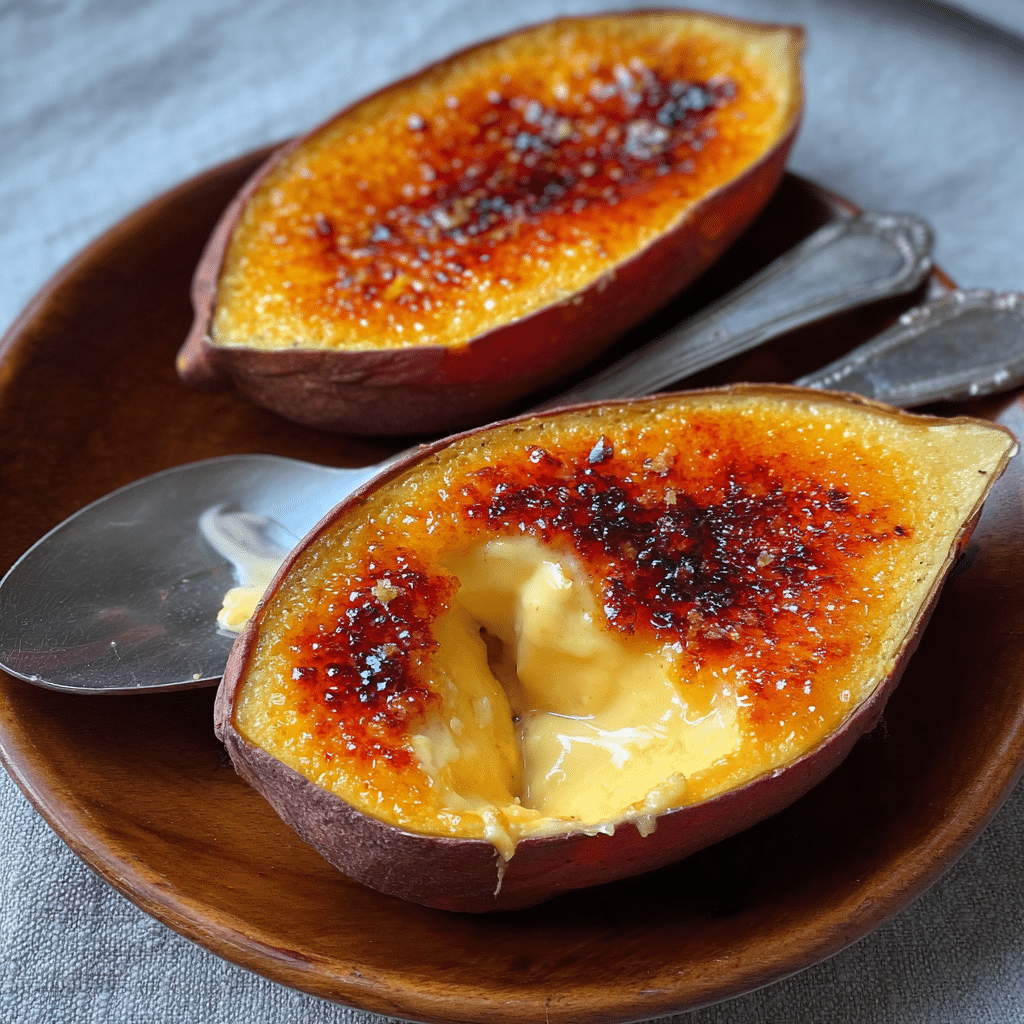The fusion of Japanese sweet potatoes and classic French crème brûlée creates a dessert that’s both familiar and entirely new. Creamy, earthy, and just sweet enough, this silky custard balances deep root vegetable notes with the light crunch of burnt sugar on top.
Perfect for cozy fall evenings or impressing guests with a unique twist, this Japanese Sweet Potato Crème Brûlée is a treat for all the senses. The roasted sweet potato adds a gorgeous golden hue and a natural sweetness that pairs beautifully with the smooth vanilla custard base. Finish it with a torched sugar shell and you’ve got an elegant dessert that’s both rustic and refined.
Full Recipe
Ingredients:
-
1 medium Japanese sweet potato (about 250g), roasted and mashed
-
1 cup heavy cream
-
1/2 cup whole milk
-
4 large egg yolks
-
1/3 cup granulated sugar (plus extra for topping)
-
1/2 teaspoon vanilla extract
-
Pinch of salt
Directions:
-
Preheat your oven to 325°F (160°C).
-
In a saucepan over medium heat, combine the heavy cream and milk. Heat until just beginning to simmer, then remove from heat.
-
In a mixing bowl, whisk the egg yolks, sugar, vanilla extract, and salt until smooth and pale.
-
Slowly add the warm cream mixture into the egg mixture while whisking constantly to prevent curdling.
-
Add the mashed sweet potato and whisk until fully incorporated and smooth. For an ultra-smooth texture, strain the mixture through a fine mesh sieve.
-
Pour the custard mixture into ramekins. Place the ramekins in a baking dish and add hot water to the dish until it reaches halfway up the sides of the ramekins.
-
Bake for 35–40 minutes, or until the custards are just set but still slightly jiggly in the center.
-
Remove from the oven and let cool to room temperature, then refrigerate for at least 2 hours (or overnight).
-
Before serving, sprinkle a thin, even layer of sugar over the tops and caramelize with a kitchen torch until golden and crisp.
-
Let the sugar harden for 1–2 minutes, then serve immediately.
Prep Time: 20 minutes | Cooking Time: 40 minutes | Total Time: 1 hour
Kcal: 290 kcal | Servings: 4 servings
A Sweet Fusion: Japanese Sweet Potato Crème Brûlée
Japanese Sweet Potato Crème Brûlée is more than just a dessert—it’s a refined blend of East and West, a creative expression of culinary harmony. This luxurious dish transforms humble Japanese sweet potatoes (satsumaimo) into a velvety custard base, topped with the signature crackling caramelized sugar crust of traditional French crème brûlée. Whether you’re a fan of French patisserie or Japanese seasonal ingredients, this dessert is bound to captivate your senses and elevate your culinary repertoire.
What Makes Japanese Sweet Potatoes Unique
The star of this recipe, the Japanese sweet potato—commonly referred to as satsumaimo—has a distinct profile compared to the typical orange-fleshed sweet potato. With a purple skin and a pale, creamy-yellow interior, Japanese sweet potatoes are celebrated for their dense, dry texture and rich, naturally sweet flavor. When roasted, their sugars intensify, creating a caramelized note that pairs beautifully with desserts. These sweet potatoes are often enjoyed roasted as a snack in Japan, especially during the colder months. Their nutritional value is also impressive—they’re high in fiber, potassium, and antioxidants, making them a wholesome base for this indulgent treat.
The French Influence: Classic Crème Brûlée
Crème brûlée is a celebrated dessert in French cuisine, known for its silky, creamy custard base and its hard caramelized sugar topping. Traditionally flavored with vanilla, this dessert strikes a perfect balance between rich dairy and caramelized sugar, with a contrast of textures that’s both satisfying and elegant. In this Japanese fusion twist, the classic custard gains depth and character from the roasted sweet potato, adding a seasonal and earthy dimension that’s both comforting and refined.
Why This Fusion Works
There’s a growing appreciation worldwide for fusing flavors from different cultures, and this dessert is a shining example. Japanese sweet potatoes bring a naturally creamy consistency and complex flavor that complements the egg-based custard of crème brûlée. The caramelized top layer remains unchanged—a satisfying nod to the original recipe—while the flavor profile takes a delicious detour into the rich, nutty sweetness that only roasted Japanese sweet potatoes can offer.
The incorporation of these potatoes also reduces the need for excessive sugar. Their natural sweetness means that the custard can be lightly sweetened without losing the rich dessert experience, making it feel slightly lighter and more balanced than the traditional version.
Texture and Flavor Profile
One of the most compelling aspects of Japanese Sweet Potato Crème Brûlée is the mouthfeel. The roasted sweet potato, when blended into the custard mixture, creates a slightly thicker, silkier texture. It’s not as eggy as some versions of crème brûlée, and it leans more toward the comforting depth of a yam pudding or Japanese custard dessert (purin).
Flavor-wise, this dish offers subtle complexity. You’ll notice warm, nutty undertones from the sweet potato, enhanced by vanilla and a hint of salt. The sugar crust, torched to golden perfection, adds a crisp contrast that shatters with a satisfying crack under the spoon, giving way to the velvety custard beneath.
Presentation and Serving Suggestions
Presentation is key when it comes to crème brûlée, and this variation is no exception. Serve it in shallow ramekins for a classic look, or try elegant glass bowls for a modern twist. The golden sugar crust should be caramelized just before serving to maintain its crispness. A few flakes of sea salt on top can provide an extra pop of flavor and enhance the sweetness.
You might also consider garnishing with a light dusting of cinnamon, a sliver of roasted Japanese sweet potato, or edible flowers for an elevated finish. This dessert pairs beautifully with green tea or hojicha, as their earthy flavors balance the custard’s richness.
Cultural and Seasonal Significance
Japanese sweet potatoes are a beloved fall and winter staple in Japan. The aroma of freshly roasted yaki-imo from street vendors is a nostalgic reminder of colder days and cozy gatherings. Incorporating this seasonal ingredient into a crème brûlée brings a touch of that nostalgia and warmth into the Western kitchen.
This recipe is especially fitting during the autumn and holiday months, when sweet potatoes are in abundance and there’s a growing appetite for warming, homey desserts with a gourmet edge.
Healthier Dessert Option
Though crème brûlée is often considered indulgent, this version has some redeeming health qualities. Thanks to the nutrient-rich Japanese sweet potato, it provides more fiber and vitamins than a standard custard. It’s also naturally gluten-free and can be adapted for lactose-sensitive eaters by using dairy-free cream alternatives like coconut cream or oat milk. You can also scale back the sugar content or use natural sweeteners like maple syrup or honey, though this may slightly alter the flavor and caramelization process.
A Versatile Dessert for Various Occasions
Whether you’re planning a quiet dinner party, a festive holiday meal, or simply want to treat yourself, Japanese Sweet Potato Crème Brûlée fits seamlessly into any menu. It can be prepared a day ahead and kept refrigerated until it’s time to serve. The final sugar-torching step adds a bit of drama and flair to your presentation—guaranteed to impress your guests.
It’s also versatile in portioning: you can make individual servings for an elegant dinner or prepare it in a larger dish for a casual family-style dessert. Its delicate balance of familiar and unexpected flavors makes it a conversation starter at any table.
Tips for Perfecting the Recipe
To achieve the best results, use well-roasted Japanese sweet potatoes that have developed a deep caramelized flavor. Ensure the custard base is smooth by blending thoroughly and straining if necessary. Baking the custard in a water bath helps it cook evenly and gently, preventing curdling or cracks. And when it comes to caramelizing the sugar, a kitchen torch is ideal—using a broiler can work in a pinch, but it’s harder to control and may not create that iconic crackle.
Also, don’t skip the chilling step. A good crème brûlée needs time to set properly in the fridge, which also enhances the flavor and texture.
Conclusion: A Dessert That Bridges Cultures
Japanese Sweet Potato Crème Brûlée stands as a beautiful example of culinary innovation. It honors the delicate sophistication of French patisserie while celebrating the earthy, naturally sweet elegance of Japanese ingredients. The result is a rich, comforting, and elegant dessert that’s both satisfying and surprising.
Whether you’re a home cook experimenting with seasonal produce or a dessert enthusiast looking for something new, this recipe delivers on flavor, texture, and visual appeal. It invites you to slow down, savor each bite, and appreciate the global language of good food.
In a world that often rushes through meals, Japanese Sweet Potato Crème Brûlée reminds us that desserts are not just an end to a meal—they’re a celebration of culture, creativity, and the joy of eating.






